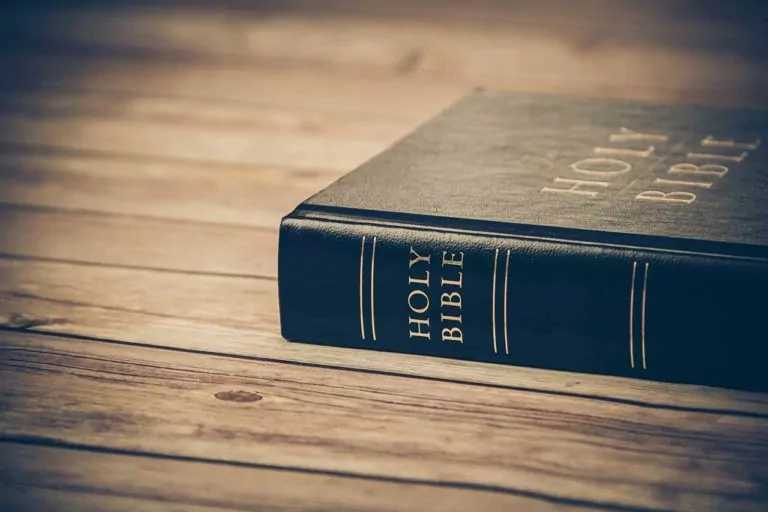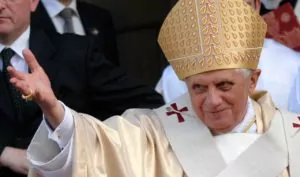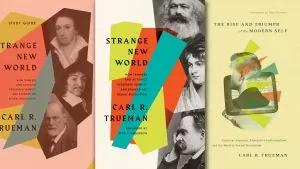Why do Protestants have 66, and Roman Catholics 73 books, in their Bibles?
We can cooperate with Roman Catholics (RC) in the pro-life movement – I have done so for many years – but we cannot overlook the divide between us. The gulf that separates us has always been theological. The RC Church says the Bible is not sufficient for our lives: she makes the audacious claim that tradition is as important as the Bible. In fact, all RC teaching regarding authority in the Church and in the life of the faithful centers on the triad of the Bible, tradition, and the magisterium (the teaching office of the Roman Catholic church with the pope as its head teacher).
In fact, Rome insists that the Bible is dependent on the Church. She defends her position on the ground that the Church both logically and historically preceded the Bible. Hence, the Biblical writings have authority because the Church receives them as holy and divine. As The New Catholic Encyclopedia puts it: “The Catholic receives the Scriptures from the infallible teaching authority of the Church.”
This view was one of the key reasons that led to a break in the RC Church. The 16th-century Reformers believed that the RC Church had substantially departed from the authority and sufficiency of Scripture. They were convinced that centuries of extra-biblical tradition had led her progressively away from the simplicity of New Testament Christianity.
The Apocrypha
The place of the Apocrypha in the RC Bible marks the difference between RC and Protestant versions. The word Apocrypha is Greek for “things that are hidden” – it is a collection of (depending on how they are divided) between thirteen and fifteen Jewish books written between circa 200 BC and 70 BC in a Semitic language other than Hebrew (such as Aramaic), or in Greek. All but a few were accepted as divinely inspired by the RC Church and integrated into their version of the Old Testament1.
In many Protestant editions of the Bible, the apocryphal books were gathered into a section of their own and usually placed between the Old and the New Testaments. In others, they were omitted. Much of the Apocrypha was rejected because of the principle of authenticity. Their historical anomalies and theological heresies made it impossible to accept them as from God despite their authoritative format – they could not be from God and contain error at the same time. And nowhere in the apocryphal books are God’s redeeming mercies in the promised Messiah exhibited, which is plainly the unifying message of the canonical Old Testament books.
Martin Luther’s Bible translation (1534) groups the Apocryphal books together at the end of the Old Testament under the caption: “Apocrypha: these are books which are not held equal to the sacred Scriptures and yet are useful and good for reading.” Article 6 of the Belgic Confession states the Reformed position:
“The Church may certainly read these books (the Apocrypha) and learn from them as far as they agree with the canonical books. But they do not have such power and virtue that one could confirm from their testimony any point of faith or of the Christian religion. Much less can they detract from the authority of the other holy books.”
To illustrate the difference between the Old Testament canon and the Apocrypha, I will focus on three books.
Tobit narrates the personal history of Tobit, a devout and charitable Jew in exile. One of the principal themes is patience under trial, with trust in divine Providence which is symbolized by the presence and action of the angel Raphael. It teaches an unbiblical conception of angels and demons.
First Maccabees recounts the background and events of the 40-year (175-135 BC) struggle for religious and political freedom led by Judas Maccabees and his brothers. It explains the feast of the Dedication of the Temple, a key event in the survival of Judaism which is commemorated in the feast of Hanukkah. The Jewish scholar, Norman Podhoretz points out that a great many American Jews would be surprised to discover that one of the most widely observed of their holidays, Hanukkah, is based on an event recounted in First Maccabees, which, written in Greek, is in the Apocrypha but not in the Hebrew Bible.
(And while we are speaking of the Hebrew Bible, it is interesting to note that while Protestants and Jews do not agree about Jesus, they do agree about which Old Testament books belong in the Bible. The Protestant Old Testament is the same as the Hebrew Scriptures (except for the order of the books). Roman Catholics, on the other hand, add additional books – Tobit, Judith, Wisdom of Solomon, Ecclesiasticus, Baruch and 1 & 2 Maccabees – as well as some extra sections to Daniel and Esther, to form their version of the Old Testament. Though most of the Old Testament books are quoted frequently by New Testament writers, these extra RC books are never quoted.)
In Second Maccabees we find one of the key passages on which the Roman Catholic Church bases its belief in purgatory: “Therefore [Judas Maccabees] made atonement for the dead, that they might be delivered from their sin.” With this text the RC Catechism encourages prayers for the dead offered explicitly in the Mass.
Tradition and the Bible
We and the Roman Catholics do agree on some things, like the shared beliefs expressed in the Apostles’ Creed. The problem with the RC Church is with what she has added.
She has always maintained that her own traditions are vehicles of divine revelation. The RC Church justifies her belief in tradition on the basis of her theory of doctrinal development. By this she means that certain doctrines were implicit in the early Church, but became explicit as the magisterium (the teaching office of the church) defined and explained them over time. The Second Vatican Council declared in the 1962 Dogmatic Constitution on Divine Revelation that there are not two separate and independent sources of divine revelation but a single divine revelation expressed and available in different forms. Thus tradition and Scripture “form one sacred deposit of the Word of God, which is committed to the Church.” It said:
“It is clear that sacred tradition, sacred Scripture, and the teaching authority of the Church, in accord with God’s most wise design, are so linked and joined together that one cannot stand without the others, and that all together and each in its own way under the action of the one Holy Spirit contributes effectively to the salvation of souls.”
Rome defines tradition this way: “as the centuries succeed one another, the Church constantly moves forward toward the fullness of divine truth until the words of God reach their complete fulfillment in her (the Church).”
This belief, however, elevates fallible human thought on par with the infallible Word of God. And what we discover is not a development of doctrine but a departure from it. The RC exaltation of tradition, the papacy, and the Church, is a depreciation of the authority of Scripture and the supreme authority of Christ. In his The Westminster Larger Catechism: A Commentary, Johannes G. Vos points out that the effect of making tradition a rule of faith and conduct along with Scripture is to make void the Word of God by the tradition of the Church. “For the Bible is interpreted in accordance with tradition, not the tradition with the Bible.”
Interpretation of Scripture
Rome does not allow private interpretation of Scripture out of fear that heresy could undermine the authority of the Bible and the Church. Pope Leo XIII (1810-1903) stated: “God has delivered the Holy Scripture to the Church, and…. in reading and making use of His Word, (men) must follow the Church as their guide and teacher.” The same Pope also said that it is impossible for any legitimate interpretation to be extracted from the Bible that is at variance with the doctrine of the Church. Any interpretation that is opposed to Church doctrine is, therefore, false.
In other words, the RC Church professes to provide divine guidance for her members. She demands recognition as the infallible interpreter of the Scriptures. Any official decision on doctrine must be accepted as final. Here the authority of the Church is openly acknowledged as superior to the Scriptures. This is contrary to the Bible and detrimental to the welfare of the Church. The 16th-century Reformers were in unanimous agreement in their opposition when Rome claimed that teaching authority lay in the magisterium with the pope as its chief shepherd under Christ.
The Council of Trent (1545-1563)
The Reformation of the Church was the Lord’s intervention to lead His Church back to the Gospel. The decline of medieval Christianity was very gradual. The more serious errors didn’t arise until as late as the 14th and 15th centuries. Eventually the result of this descending darkness was serious. The problem was with what Rome had added to the Bible over the centuries.
In the wake of the Reformation, the Council of Trent was called to reform the RC church from within. In their discussions, the council clearly had the writings of Luther and Calvin in mind. But the doctrinal positions adopted by the Council of Trent were essentially restatements of beliefs and practices of the later Middle Ages. These were teachings that the Protestant Reformers had struggled against. The line between RC’s and the Reformers became clear through the decisions made by the Council of Trent, especially when it declared tradition and the Bible equal sources of faith.
Since the Council of Trent the question of canonicity has been settled. On April 8, 1564, it listed by name the sacred and canonical books of both Testaments: 46 (45 if Jeremiah and Lamentations are counted as one) for the Old Testament and 27 for the New Testament. And it added:
“If anyone, however, does not accept as sacred and canonical, the same books entire with all their parts, as they are accustomed to be read in the Catholic Church and as they are contained in the Old Vulgate Latin edition… let him be anathema.”²
Since the Council of Trent, the books of the Apocrypha have had binding and canonical authority in the RC Church.
Bible Reading
In 1898, to encourage Scripture reading, Leo XIII promised that anyone who read the Bible at least 15 minutes a day would earn an indulgence3. A notice concerning these indulgences is ordinarily printed in the first pages of Bibles published for RC.
Bible reading, private and liturgical, is strongly encouraged as a means to spiritual perfection, although it is not necessary for salvation. The Catechism states: “The Church ‘forcefully and specifically exhorts all the Christian faithful…to learn the surpassing knowledge of Jesus Christ’ by frequent reading of the divine Scriptures. Ignorance of the Scriptures is ignorance of Christ.'” Today the hunger for the knowledge of Scriptures among countless RC is apparent. Many have joined Bible study groups.
Conclusion
At this juncture, we may well ask whether recent developments in the RC Church show a reversal of unbiblical positions. The Second Vatican Council (1962-1965) opened the door for new discussions with Protestants in general, and more recently with evangelicals in particular. But did it officially change the older doctrines that precipitated the great divide of the sixteenth century? Has the Council of Trent been formally reversed by these new developments? Not at all! New formulas have been adopted; a new way of thinking has been embraced. But the decisions made by the 16th century Council of Trent still stand.
In other words, churches in the Reformed tradition should reaffirm that the Bible alone is the Word of God. By that Word alone the Church lives. The Church ought never to say anything less than the Bible does. Neither is she authorized to say anything more, lest she fall into grievous error by attempting to be wiser than God whose will is sufficiently taught in His Holy Word. The Bible and the Bible alone is the Christian’s infallible rule for faith and practice. The historian J.H. Merle d’Aubigne wrote many years ago, “The only true reformation is that which emanates from the Word of God.” Ultimately the greatest fruits of the 16th century Reformation will be lost if we turn away from the Gospel and the Word of God.
End notes
1 If you end up talking to Roman Catholics about this subject you should be aware that they use the word Apocrypha differently. They don’t apply it to the extra books in their Bible, but rather to books outside their Bible that claim authorship by either Old Testament figures (like The Apocalypse of Abraham) or New Testament writers (like the Gospel of Peter).
2 “Anathema” is the same as our “excommunication.” In the RC Church you can receive a minor excommunication – exclusion from the sacraments – or a major excommunication also known as anathema, which The Catholic Encyclopedia, Volume I describes as “being excluded from the society of the faithful.”
3 Roman Catholics believe that even after a sin is forgiven a payment still needs to be paid. Indulgences can be used to make this payment. To restate it, when God forgives a sin, the eternal punishment for that sin – Hell – is eliminated, but Roman Catholics believe that temporal punishment for the sin must still be endured – the believer must spend some time in Purgatory. Every indulgence earned, means less time in Purgatory.
Rev. Johan Tangelder (1936-2009) wrote for Reformed Perspective for 13 years. Many more of his articles can be found on his blog Reformed Reflections.















